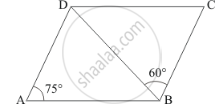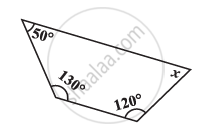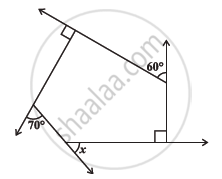Advertisements
Advertisements
Question
In Fig. below, ABCD is a parallelogram in which ∠DAB = 75° and ∠DBC = 60°. Compute
∠CDB and ∠ADB.

Solution

To find `∠`CDB and `∠`ADB
`∠`CBD = `∠`ABD = 60° [Alternative interior angle AD || BC and BD is the transversal]
In a parallelogram ABCD
`∠`A = `∠`C = 75° [ ∵ Opposite side angles of a parallelogram are equal]
In `∠`BDC
`∠`CBD + `∠`C + `∠`CDB =180° [Angle sum property]
⇒ 60° + 75° + `∠`CDB = 180°
⇒`∠`CDB = 180° - (60° + 75°)
⇒ `∠`CDB = 45°
Hence `∠`CDB = 45°, `∠`ADB = 60°
APPEARS IN
RELATED QUESTIONS
Find the angle measure x in the given Figure


Find x + y + z + w
Find x in the following figures.

In the given figure, ABCD is a rectangle in which diagonal AC is produced to E. If ∠ECD = 146°, find ∠AOB.
Diagonals necessarily bisect opposite angles in a
The two diagonals are equal in a
In ΔABC, ∠A = 30°, ∠B = 40° and ∠C = 110°. The angles of the triangle formed by joining the mid-points of the sides of this triangle are
Can the angles 110º, 80º, 70º and 95º be the angles of a quadrilateral? Why or why not?
Can all the angles of a quadrilateral be right angles? Give reason for your answer.
The angles P, Q, R and S of a quadrilateral are in the ratio 1:3:7:9. Then PQRS is a ______.
